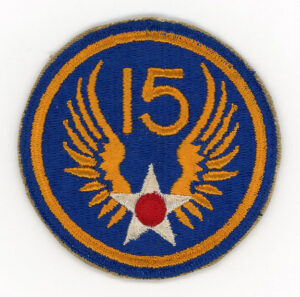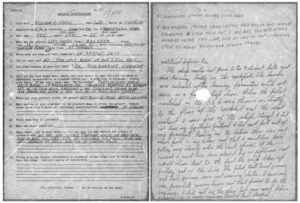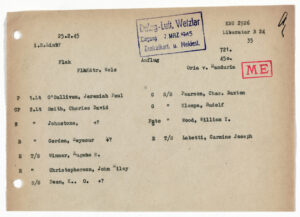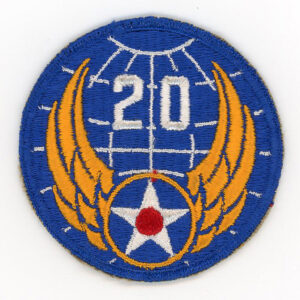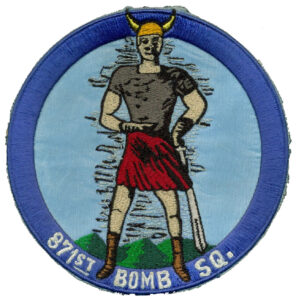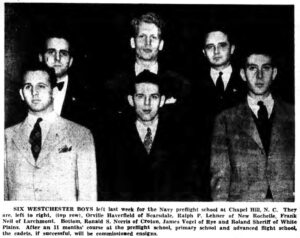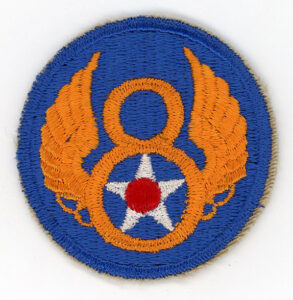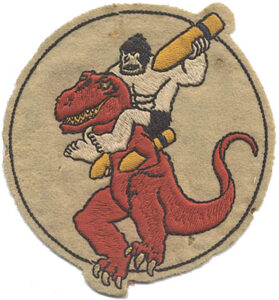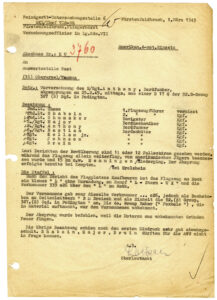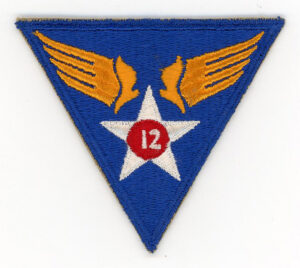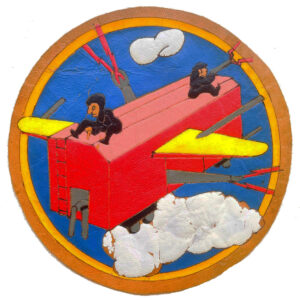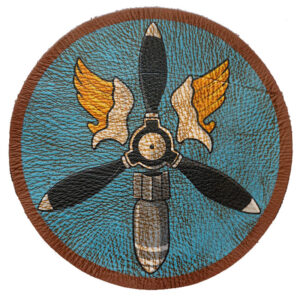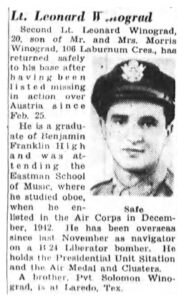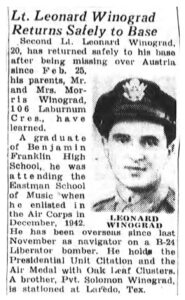“Seguing” from the posts covering Jewish military casualties of February 25, 1945, in the ground forces of the Allies, United States Navy, and United States Marine Corps, this third post pertains to Jewish members of the United States Army Air Force….
______________________________
For those who lost their lives on this date…
Sunday, February 25, 1945 / Adar 13, 5705
– .ת.נ.צ.ב.ה. –
…Tehé Nafshó Tzrurá Bitzrór Haḥayím
May his soul be bound up in the bond of everlasting life.
______________________________
9th Air Force
323rd Bomb Group, 455th Bomb Squadron
“Sine Alis Volamus” – “We Fly Without Wings”
(Via Military Insignia Products, the emblem of the 455th Bomb Squadron.)
Diamond, Carl Hershman, Sgt., 32900336, Radio Operator
Killed in Action
Aircraft: B-26C 41-34952 “Ginny Lou / Anahuac Lion“ – “YU * Q”; Pilot: 2 Lt. Richard N. Brown; 6 crew members – no survivors
MACR 12733; Luftgaukommando Report KU 3759
Germany, Koln (20 km SW); Lechenich (3 km NW)
Born Brooklyn, N.Y. 3/15/24
Mr. and Mrs. Morris (10/15/87-9/74) and Anna (Wikitsky) (1887-?) Diamond (parents), 501 Wyona St., Brooklyn, N.Y.
Mrs. Rose (Diamond) Glasser (sister); Sidney Glasser (brother in law)
Place of burial unknown
American Jews in World War II – Not Listed
Ginny Lou / Anahuac Lion received a direct hit by flak in its left engine during a mission to “Germany” (that’s exactly how the destination is listed in MACR 12733) after crossing the “bomb line”. The engine and port main fuel tank burst into flames, with bombardier Ernest Pierucci salvoeing the aircraft’s bomb-load a moment later. The plane turned off on its left wing, going downward into a slow spin while on fire. None of the bomber’s crew were able to escape from the aircraft, which exploded on impact.
The B-26’s crew consisted of:
Pilot – Brown, Richard Noyce, 2 Lt.
Co-Pilot – Hoffman, John C., 2 Lt.
Bombardier – Pierucci, Ernest J., 2 Lt.
Radio Operator – Conderman, Rollin J., Sgt.
Flight Engineer – Diamond, Carl, Sgt.
Gunner – Pegues, Robert Alton, Sgt.
According to Luftgaukommando Report KU 3769, Ginny Lou / Anahuac Lion crashed 3 km northwest of Lehenich, 10 km west of Bruehl, 20 km southwest of Koln. Very little remained of the aircraft.
Sergeant Diamond has been an enigma. His name is absent from American Jews in World War II, and similarly, doesn’t appear in any casualty list covering the New York Metropolitan area. His family could only be identified via Ancestry.com, based on the name and address of his sister as listed in the next-of-kin sheet in MACR 12733. Unlike his five fellow crewmen, his place of burial – I suppose somewhere in the environs of New York City? – is unknown.
“Ginny Lou” herself – or perhaps another B-26 with the same nickname? – can be seen in this official Army Air Force photograph (75310AC / A2771) taken at Meeks Field, Iceland, while en route to England, on May 27, 1943. The aircraft is in the very center of the image, where it’s among several Marauders under care of the 2nd Service Group.
15th Air Force
301st Bomb Group, 352nd Bomb Squadron
“Navigator – reported by bombardier as in ship with parachute on.”
Bernstein, Robert, 2 Lt., 0-2071497, Navigator, Air Medal, Purple Heart
Killed in Action
Aircraft: B-17G 43-38505; Pilot 1 Lt. Ralph W. Steuve; 10 crew members – 3 survivors
MACR 12474; Luftgaukommando Reports KSU 2928 (only one page) and ME 2928 (unavailable via NARA.com)
Born Brooklyn, N.Y. 5/6/22
Mrs. Alice C. Bernstein (wife), 1515 47th St., Brooklyn, N.Y.
Mr. and Mrs. Harry “Henry S.” (6/7/92-11/21/63) and Anna (Halperin) (1901-8/67) Bernstein (parents)
Mrs. Marilyn Davis and Mr. Richard Bernstein (sister and brother)
Beth David Cemetery, Elmont, L.I., N.Y. – Section 1, Block 3, Bernstein Family Circle (corner of Sunset and Brandeis Avenues); Buried 10/17/48
Casualty List 2/24/46
New York Times Obituary Section 10/16/48, 10/17/48
American Jews in World War II – 276
During a mission to marshalling yards at Linz, Austria, un-nicknamed Flying Fortress 43-38505 – while over the target – was struck by flak directly in its #4 (right outboard) engine and wing a few seconds before bomb release. Lt. Ralph Steuve pulled the bomber out of the 301st’s formation by dropping back and down, and moved off to the right, as flames streamed from the damaged engine to the trailing edge of the wing.
After clearing the formation, the burning plane began a gentle turn to the right. By the time the bomber had made a 180-degree turn, two men were seen to have bailed out from the plane. Shortly afterwards the right wing exploded, and the plane began to spin, burning as it fell, by which time it had fallen 2,000 feet below the 301st’s other B-17s. The plane was last seen to be spinning downwards, a moment before 1 o’clock in the afternoon, through a clear and cloudless Austrian sky.
Of the bomber’s ten crewmen there emerged three survivors:
Co-Pilot – Varns, William E., 2 Lt. (New Haven, Ct.)
Bombardier – Koch, William Eaton, 1 Lt. (Elmhurst, Il.)
Flight Engineer – Bernard, Albert Silvo, T/Sgt. (Chandler, Az.)
Luftgaukommando Report KSU / ME 2928 is vague about the location of the plane’s loss, only stating that the bomber crashed at “Linz / Danube”. Of the three survivors, the only crew member to have returned a Casualty Questionnaire to the Army was the co-pilot, Lt. Varns. His report verified the observations of eyewitnesses in the 301st’s formation, simply stating that the plane blew up over Linz (over the edge of the Danube River) and that of the nine other men on the plane, only the bombardier and flight engineer actually bailed out. Presumably, they were the two men seen parachuting as the bomber turned away from the formation. As for Lt. Varns himself, he wrote, “The ship blew up, and I fell free.”
Otherwise, he stated that:
Pilot – in seat when ship blew – no parachute on. Navigator – reported by bombardier as in ship with parachute on. Engineer salvoed bombs and bailed out when I got out of co-pilot seat (over)
The ship sustained 2 to 4 direct hits and was burning badly in the cockpit. The bombs were salvoed after leaving formation while we were in a fairly steep dive. When the pilot switched on the C1 [autopilot; see more about the use of the C-1 at Archive.org] I was thrown violently to the floor of the cockpit and the next instant I was free of the ship. Though I did not have my leg straps fastened I did not fall out of my parachute leading me to believe there was not much pull on my arms and that I must have been falling very slowly when the ‘chute opened. If this is correct I must have been slowed by an explosion and would also lead to the fact that the ship blew up pulling out of the dive. The pilot, ball turret gunner, and tail gunner were not wearing ‘chutes. I saw only one parachute coming down and that proved to be the engineer. I did not see the plane but saw much debris around me i.e. engine cowlings, part of tail identified.
An image of Lt. Varns’ Casualty Questionnaire appears below. (The extremely poor quality of the Fold3 image, replete with scratches on microfiche, is plainly obvious. And rather typical.)
It seems that Lt. Varns remained in the postwar Air Force, attaining the rank of captain. He passed away at the young age of 35, in 1958. Sgt. Bernard passed away in 1988.
450th Bomb Group, 721st Bomb Squadron
“It is hard for anyone to imagine what really did happen.
The explosion was terrific and it all happened so fast.
It is a miracle that any of us came through it alive,
and also so hard to understand just why three swell fellows had to give their lives.”
(This image of the 721st Bomb Squadron insignia is via Pinterest.)
Gordon, Seymour, 2 Lt., 0-776980, Bombardier, Air Medal, Purple Heart, 7 missions
Killed in Action
Aircraft: B-24J 44-41188 “35”; Pilot 1 Lt. Jeremiah P. O’Sullivan; 12 crew members – 9 survivors
MACR 12510; Luftgaukommando Report ME 2926
Born New York, N.Y. 3/9/20
Mrs. Shirley Frances Gordon (wife), 1144 Vista St., Los Angeles, Ca.
Mr. and Mrs. Max and Gertrude Gordon (parents), 2450 72nd St., New York, N.Y.
Also 2441 St. Paul St., Baltimore, Maryland
Tablets of the Missing at Epinal American Cemetery, Epinal, France
American Jews in World War II – Not Listed
Another aircraft lost during a mission to the Linz marshalling yards…
B-24J Liberator 44-41188, squadron number “35”, received a direct flak hit in the nose just before “bombs away”. The aircraft slid back within the formation, seemingly almost out of control, but Lieutenant O’Sullivan managed to regain control of the plane and peeled away to the left of the 450th Bomb Group’s formation. A large hole had been blown in the left side of the aircraft’s nose section, immediately behind the nose turret and extending from the floor to roof of the fuselage, but the bomber’s four engines were still operating and the plane remained controllable.
Nine of the bomber’s twelve crew members parachuted from the damaged plane after the bomb load was dropped. All these men landed safely, were captured, and survived the war as POWs.
According to Luftgaukommando Report ME 2926 (just a single sheet of paper – that’s all there is) the plane crashed – like above-mentioned B-17G 43-38505 – in the very ambiguous location of “Linz / Danube”. The three crew members in the nose – bombardier 2 Lt. Seymour Gordon, navigator 2 Lt. Frank Alfred Johnstone, and nose gunner Sgt. Kenneth Olen Dean – were killed instantly. According to statements by T/Sgt. Eugene M. Winner (one of the bomber’s gunners) in his postwar Casualty Questionnaire, a German soldier – a member of the Luftwaffe – showed Lt. O’Sullivan the three men’s dog-tags, and reported that 44-41188 crashed into a mountainside near the crew’s place of capture, possibly in the vicinity of Styer, Austria. However, of the three casualties, only Sgt. Dean actually has a place of burial. Gordon and Johnstone are both commemorated on the Tablets of the Missing at Epinal American Cemetery and Memorial in France.
This image, via Roy Heim, shows Sgt. Dean and – probably – five other members of the O’Sullivan crew, the crew’s four officers possibly in the group. The photo is from Kenneth Dean’s biographical profile at FindAGrave.
The events of February 25, 1945, are described in this letter from Charles L. Smith, co-pilot of “35“, to Mrs. Myrl Irene Dean, mother of nose-gunner Kenneth Olean Dean. The letter, also via Roy Heim, is from the 450th Bomb Group Memorial Association Website.
1400 Morton Street, Apt. B
Lafayette, Indiana
January 21st, 1947
Dear Mrs. Dean:
I received your letter last week. The reason I haven’t written you before now is because I thought it might be a little easier for you if I didn’t write. I would like to keep in contact with you, and certainly want you to feel free to write me at any time you feel you would like to write.
I, too, cannot understand why the army would move Kenneth’s body ever five hundred miles when there must he thousands of our boys in cemeteries in Austria and Germany.
We had an extra engineer and a cameraman along the day we were shot down, and as I was not positive which one of the engineers was in the top turret at the time, I immediately wrote a letter to our regular engineer Carmen Labetti [Sgt. Carmine J. Labetti]. You probably remember Kenneth mentioning “Lab” in his letters home. I received a special delivery airmail from “Lab” today, and he confirmed my belief that he was in the top turret. It was Labetti who I had check on the men in the nose. He too says that the turret was still hanging on the nose of the plane. There were only the four of us (pilot, myself, the extra engineer and Labetti) on the flight deck and the rest of the crew that escaped with their lives were in the waist of the ship behind the bomb bays. The boys in the waist and the tail bailed out the escape hatch in the waist and never came to the forward part of the plane. To another plane in the formation I imagine it did look as though the nose was blown off as that is where the shell exploded and pieces of metal, glass, equipment, maps, etc. tore out of the nose section. Others in the formation couldn’t have had more than a momentary view of our ship, as we sliced across the top of our formation and were left behind immediately.
It is hard for anyone to imagine what really did happen. The explosion was terrific and it all happened so fast. It is a miracle that any of us came through it alive, and also so hard to understand just why three swell fellows had to give their lives. It may help a little to know that the boys were probably busy watching for the bombs to be released, and they never knew what happened or suffered any pain.
I was the last man to be picked up by the Germans, and that evening when I joined the rest of the crew, a German guard showed us Kenneth’s dog tags. Labetti also remembers seeing Kenneth’s dog tags. I also asked “Lab” about Kenneth’s crash bracelet, but he didn’t mention anything about it in his letter. I would imagine that Kenneth was wearing it, if it didn’t come home with his other belongings.
Mrs. Dean, Kenneth didn’t join my crew until about the middle of our training at March Field and the pictures I took in Italy were not returned to me, so I thought perhaps you might have a negative from which I could have a picture of Kenneth made.
I have been out of the army for ever a year and a half now. I tried going back to college (Purdue University), but that didn’t work out too well.
However, my wife, little boy and I are still living here in Lafayette, and I am now working at the Packard Garage here. My little boy is two years old and he really keeps things lively at home.
I hope I have answered all your questions, and again — we’d like to hear from you.
Labetti’s address is:
1169 Bay Street
Staten Island, 5, New York
if you would like to write him.
sincerely yours,
Charles Smith
The document below is the single sheet comprising ME 2926, which lists the full names of eight of the plane’s crew members, and, partial to complete names for Gordon, Johnstone, and Dean. Despite Gordon and Johnstone being listed on the Tablets of the Missing at Epinal American Cemetery, this document suggests that German investigators at the very least discovered the men’s dog-tags, leading to the possibility that their remains might (might) be buried in that cemetery as unknowns…
20th Air Force
497th Bomb Group, 871st Bomb Squadron
Even the most cursory review of WW II military aviation history will reveal the significant proportion of aircraft and aircrew losses that were not directly attributable to enemy action. Such was the case for the loss of two B-29 Superfortresses of the 497th Bomb Group’s 871st Bomb Squadron, during the February 25th mission to urban areas in Tokyo.
As recorded in Missing Air Crew Reports 12721 and 12722 (the two documents are effectively interchangeable, given the nature of the incident) the two bombers were approaching the Assembly Point of the 73rd Bomb Wing when the unnicknamed airplane A square 45 (42-24808 with 12 airmen aboard, piloted by 1 Lt. Jack S. Barnes) pulled into formation above A square 44 (42-63431 with a crew of 11, piloted by 1 Lt. Austin R. Keith and otherwise known as Ponderous Peg). At an altitude of 1600 feet, the two bombers collided; it was impossible to determine which aircraft moved improperly. A square 44 broke apart, while A square 45 entered a ninety-degree bank with both inboard engines dead, and descended to the sea.
A third B-29 (A square 51) remained in the area, searching the crash location of A square 45 at very low altitude for any signs of life. Nothing was seen except for floating oxygen bottles, two inflated crew life rafts, and a single-man life raft.
This photograph of Ponderous Peg (62609AC – A38499) was taken in on Saipan in November of 1944.
Evidently, the aircraft’s nose art was revised subsequent to November of 1944, as seen in this photo.
Here’s a view of Ponderous Peg from another perspective. In this image from the Athey Family, A square 45’s tail is barely visible in the middle of the left-center window of the bombardier’s station … it’s just to the left of the propeller on the #4 engine of the B-29 directly ahead.
As noted in the MACR, weather conditions at the time of the accident were “ceiling and visibility unlimited”. Though the cause of the accident will never be known (well, among men), I’d suggest that it was a case of distraction or complacency, and if so the latter ironically because of the ideal weather conditions.
The bombardier of Lt. Barnes’ aircraft was 2 Lt. Roland Sheriff (0-928781), who was born in Manhattan on March 12, 1922. The son of Barney (4/4/93-11/12/70) and Violet (Hutt) (8/2/01-11/76) Sheriff, and brother of Sonya, the family resided at 86 Concord Ave. in White Plains, New York, and possibly had a connection to Essex County, Massachusetts. Given that Lt. Sheriff received the Air Medal and Purple Heart, the flight of February 25, 1945 was probably his fifth to ninth combat mission.
This is the only image of Roland Sheriff I’ve been able to locate. He appears at lower right, in this photograph published in the Mount Vernon Daily Argus on October 27, 1942. Notably, he was first interested in becoming a naval aviator.
In a pattern (for lack of a better word!) seen many times before, Lt. Sheriff’s name is absent from American Jews in World War II, though news items about him did appear in the Mount Vernon Daily Argus on 10/27/42 and 3/3/45, and Yonkers Herald Statesman on 3/3/45 and 3/31/45. His name is commemorated at the Tablets of the Missing, at the Honolulu Memorial, in Honolulu, Hawaii. (Curiously, the MACR name index card for Lt. Sheriff states “No MACR”, however, the MACR for this crew – #12721 – obviously, very much exists.)
______________________________
____________________
______________________________
Whether as prisoners of war, internees, or evaders, the following men returned…
8th Air Force
92nd Bomb Group, 327th Bomb Squadron
As reported in MACR 12719, B-17G Flying Fortress 43-39026 (Reba Jane / UX * L) lost two engines to flak and caught fire during a mission to Munich. The bomber’s crew of nine survived by parachuting from their damaged plane. They all survived as POWs and returned to the United States a few months later.
Luftgaukommando Report KU 3760 provides a substantive report about the crew’s capture, the identification of their bomber (or, what was left of it?!), and the determination of the squadron and group to which men and plane were assigned. The report sheds a little insight onto the German perspective of obtaining military intelligence from captured airmen, paying an ironic tribute to three of Reba Jane’s crewmen – co-pilot Lt. Shabsin, flight engineer S/Sgt. Major, and gunner Sgt. Bruin – for their refusal to reveal information to their captors. As stated in the “Angaben über Gefangennahme von feindlichen Luftwaffenangehörigen” (Report on Capture of Members of Enemy Air Forces) form for Lt. Shabsin, “Nähere Angaben wurden von dem Kgf. [Kriegsgefangen] verweigert.” – “More specific information was refused by the prisoner of war.”
Here’s a translation of a page in Luftgaukommando Report KU 3760:
Subject: Preliminary interrogation of S/Sgt. Anthony, Radio operator, who parachuted from a B 17 G of the 92nd Bomb-Group, 327th Bombardment Squadron, stationed in Podington, 25 . February 1945 at midday.
Crew:
2nd Lt. Chase – Pilot – missing [2 Lt. Frank J. Chase]
2nd Lt. Shabsin – Co-pilot – prisoner [2 Lt. Edward Shabsin]
2ns Lt. Shumaker – Navigator – prisoner [2 Lt. Donald E. Shumaker]
S/Sgt. Major – Mechanic – prisoner [S/Sgt. Roydon D. Major]
S/Sgt. Anthony – Radio operator – prisoner [Sgt. Rudolph A. Anthony]
S/Sgt. Bastian – gunner – prisoner [S/Sgt. Raymond C. Bastian]
Sgt. Kellam, Jr. – gunner – prisoner [Sgt. William F. Kellam, Jr.]
Sgt. Johnson – gunner – prisoner [Sgt. Victor L. Johnson]
Sgt. Bruin – gunner – prisoner [Sgt. Stanley M. Bruin]
According to reports made by the population 11 or 12 parachutes were observed, whereas the plane flew on by itself, was then shot down by American fighters and crashed near Erolsheim, 15 km. NW of Memmingen. The crew had already parachuted near Kempten.
The Squadron:
According to the report of Airbase Kaufbauren the plane’s identifications are : a blue L without frame on the tail, L-star U X / and the manufacturer’s number 339026 above the L on tail. (on fuselage)
Interrogated prisoner gave the same manufacturer’s number …026, but claimed the letter on the tail-unit to be : B in triangle; his unit is 92nd Bomb Group, 337th Bomb-Squadron in Podington. The 40th Group Baker (“Foxhole”), which appears in the records he claimed not to know anything of.
The order to bail out had been given because fire broke out in the engines from no apparent reasons.
The remainder of the crew, to judge by first impressions, seemed to be very well trained in resisting intelligence operations. Shabsin, Major and Bruin will probably not be suitable for transfer to Evaluation Point West.
And… Here’s the actual page in question:
And, what of 2 Lt. Edward Shabsin, otherwise “0-828552”?
Born in Chicago on January 25, 1921, he was the son of George (7/1/92-10/7/70) and Belle (Wolf) (5/14/95-11/1/74) Shabsin, the family residing at 3355 Potomac Ave. in that city. The bomber’s co-pilot, he received the Air Medal, suggesting that the mission of February 25 was his fifth to tenth combat flight. He passed away on April 13, 1993, and is buried at Greenwood Memorial Park, in San Diego, Ca. His name does appear in American Jews in World War II – specifically, on page 116. Otherwise and obvious by this account, he was most definitely a POW, but – not uncommonly for men captured in the European Theater towards the end of the war – the POW camp in which he was interned is unknown.
351st Bomb Group, 509th Bomb Squadron
The loss of Torchy Tess / RQ * V, a B-17G Flying Fortress of the 351st Bomb Group’s 509th Bomb Squadron, is covered in Missing Air Crew Report 12728, and in very great detail on pages 67 through 69 in Volume II of Hans-Heiri Stapfer’s Strangers In a Strange Land. Struck by flak during a mission to Munich (the crew’s second mission), the bomber, 43-37854, was last seen at 7,000 feet near Lake Constance, Switzerland, being escorted by three fighters.
As revealed in flight engineer Sgt. Clinton O. Norby’s account, flak severely damaged the left side of the fuselage, particularly the pilot’s windows, flight controls, and instruments, placing the burden of flying the aircraft on the co-pilot, 2 Lt. Harold V. Gividen. The explosion had also wounded the nose gunner and navigator. The escorting fighter planes turned out to be Swiss aircraft, as denoted by their white-cross-on-red-square national insignia.
The aircraft gradually descended as it flew onwards, with Norby recollecting, “…I could see that we were going to crash, and not on a flat piece of ground. … I looked at the air speed and it was indicating 140 mph. This surprised me as we usually cruised at 130 mph indicating. Three things came to my mind: this was going to be a bad crash, we still had over 1,000 gallons of gas onboard, and I was worried about fire.”
By the time the aircraft impacted, the engines had stopped running, the only noise coming from the aircraft hitting treetops. As the aircraft slowed, the last tree it hit, “…was a very large one and we hit on the left side of the plane, wrapped around it and stopped.” The front of the aircraft had been demolished, with pilot Abplanalp having been killed in the crash. The seven other crew members survived, with the co-pilot, navigator, and two waist gunners, wounded by flak or injured in the landing, being taken to a hospital in Lucerne.
This mission was the first or second combat flight of the plane’s radio operator, Sergeant Paul Levinson (16168993). The son of Benjamin G. and Jennie (Golden) Levinson and brother of Elaine, his family’s home address was 5959 Kenmore Ave., Chicago, though another address may have been 3143 Wilson Ave. in the same city. His name appears on page 378 of American Jews in World War II, which – by the lack of any other information – suggests (?) that he received no medals or awards. Born in Chicago on April 23, 1923, he passed away on March 7, 2007.
351st Bomb Group, 508th Bomb Squadron
No Missing Air Crew Report exists for B-17G 42-97843 of the 351st Bomb Group’s 508th Bomb Squadron. This is because the bomber (YB * C), which lost two engines to flak during a mission to Munich, and then a third after leaving that target, landed on its remaining engine at a French fighter airfield at Lunéville, with its co-pilot – Carl Stahl – seriously wounded in his right foot and leg by flak. Thus, neither the plane nor crew were missing for the 48-hour time period allotted before a MACR would be filed.
Also wounded, though the specifics are unknown, was the plane’s bombardier, 2 Lt. Norman Rosenblatt (0-1304955), who was awarded the Air Medal and one Oak Leaf Cluster, and of course the Purple Heart. This was his 19th combat mission. The husband of Rosalind Rosenblatt of 87 Woodruff Ave., Brooklyn, his name can be found on page 418 of American Jews in World War II, while this incident is noted on pages 67 and 130 of A Chronicle of the 351st Bomb Group (H). A review of the MACR name index reveals the notation “No MACR” on the file card bearing his name.
Other known crew members were YB * C’s pilot, 1 Lt. Robert A. Sandel, navigator 1 Lt. Edward H.L. Clarac, Jr. (also wounded: “A fragment of a German 88mm shell nicked Ed’s neck and tore through his throat mike, putting a hole in his scarf and tearing thru his B-10 jacket.”), and tail gunner Arthur Kemp.
486th Bomb Group, 835th Bomb Squadron
(This reproduction of the 835th Bomb Squadron’s strange yet colorful insignia was created by EBay seller abqMetal.)
Though a Missing Air Crew Report – # 12578 – was certainly filed for B-17G 43-38648 H8 * H of the 486th Bomb Group’s 835th Bomb Squadron, unfortunately, the document is not accessible through NARA. (So, what else is new? I can only surmise – ? – that this MACR – as copied in digital format from microfiche masters – is one of the many Missing Air Crew Reports, created by Fold3 which are of such abysmal quality as to be barely readable, or, completely illegible (out of focus, contrast ridiculously low or high, and heavily adorned with damage, scratches, and smudges that obscure individual frames of the MACR), to the point of being inaccessible when searching through NARA’s online catalog.)
Fortunately, the story of the loss of this crew and plane can be reconstructed from other sources. These include the American Air Museum in Britain, Jing Zhou’s B-17 Bomber Flying Fortress – The Queen of The Skies, Luftgaukommando Report KU 3738, and the 486th Bomb Group Association’s website. The latter reveals that during the Group’s mission to Neuberg, Germany, the aircraft, piloted by 1 Lt. William C. Wiley, “…suffered a flak hit in the right wing, leaving a gaping hole. The aircraft’s right inboard engine was feathered and no gasoline was getting to the #3 engine, which was feathered and #4 was smoking. The aircraft was losing altitude and falling behind the formation. Lt. Wiley managed to make a wheels up landing near Altstödten, Germany.” The entire crew was captured and eventually returned to the United States.
In terms of photos, Lt. Wiley can be seen here, while five of the crew’s six enlisted men can be seen here. The crew list, below, has been reconstructed from data at the 486th Bomb Group’s website and the Luftgaukommando Report. The formation plan for the mission is available here.
Pilot – 1 Lt. William C. Wiley
Co-Pilot – 2 Lt. Donald J. Demerath
Navigator – F/O Demetrios G. Maurides
Gunner (Nose) – S/Sgt. Clarence M. Baugh
Flight Engineer – T/Sgt. Curtis L. Jessen
Radio Operator – S/Sgt. Donald Wilbur Brown
Gunner (Ball Turret) – S/Sgt. Keith G. Splude
Gunner (Waist) – S/Sgt. George Rubin
Gunner (Tail) – S/Sgt. James B. Manford
There are two great photos of H8 * H….
This image, at the 486th Bombardment Group website, shows the aircraft in flight, viewed from above, with contrails behind. This image is via George Rubin.
Here’s a high-resolution close-up of the same photo, via the American Air Museum in Britain. (Image UPL 37758.) Clearly visible is the red and blue chevron on the plane’s right wing.
This image, also at the 486th Bomb Group website, via George Rubin, shows H8 * H, draped by German soldiers with foliage for concealment from Allied fighters (good luck with that, given the yellow tail, triple-yellow striped fuselage, and color chevron on the starboard wing!) after its crash-landing.
Luftgaukommando Report 3738 is remarkably comprehensive in its description of the condition, examination, and recovery of H8 * H. The report states that the aircraft made an emergency landing 2 kilometers south of Sonthofen / Allgäu at 1255 hours.
This Oogle map shows Sonthofen relative to Munich and the Swiss border. The city is directly south of Kempten, which is in the center of the map. The mountaintops south of these cities probably correspond to those seen at the left center of the above photo, in the distance beyond the B-17. If so, this would indicate that the plane was heading south when it landed, suggesting that the crew had hoped to reach Switzerland.
Oogling in, we can see Sonthofen, and, Burgberg im Allgäu in the map’s center. The probably crash-landing location is denoted by the red circle.
A map view at an even larger scale reveals the area – the Iller River valley – in greater detail.
S/Sgt. George Rubin (32991833) was born in Brooklyn on May 7, 1925, the son of Dr. and Mrs. William and Rita Rubin, of 240 Utica Ave. The recipient of the Air Medal with three Oak Leaf Clusters (thus suggesting he completed between fifteen and twenty combat missions), and Purple Heart, his name can be found on page 423 of American Jews in World War II.
12th Air Force
340th Bomb Group, 489th Bomb Squadron
(Via Pinterest, and I think (?) designed by PzD501 and featured at TeePublic, here’s the insignia of the 489th Bomb Squadron. For those with a bent towards literature and science fiction, this is the military unit in which Walter M. Miller, Jr., author of the acclaimed novel A Canticle for Liebowitz, served as a radio operator.)
Bubbies / 9G, a B-25J Mitchell that officially went by the serial number 43-4062, was shot down by anti-aircraft fire during a mission to Vipiteno, Italy. As described in MACR 12707, the aircraft, piloted by 1 Lt. Gayle C. Gearheart and leading an element of three 489th Bomb Squadron Mitchells, was seen by 2 Lt. Charles Huber, Jr. (piloting a B-25 in the number three position) was seen to be throwing fuel or oil from its port engine, which seemed to quit, and then was feathered. When last seen, Bubbies was heading up a valley under escort by two fighters, apparently under control and maintaining its altitude. Lt. Gearheart informed Lt. Huber that he was, “okay, and not to stay with him”.
Fortunately, the entire crew survived. As reported by 2 Lt. Wendell H. Beverly (co-pilot), Sgt. Harold Schoenholtz (radio operator / gunner), and Sgt. Albert D. Taylor (tail gunner) in their postwar Casualty Questionnaires, the aircraft was crash-landed in the vicinity of “Glurn”, “Glurns”, or “Glorenza”, Italy, while Luftgaukommando Report ME 2923 lists 9G as having landed 200 meters northwest of “Graun” at 13:25 hours. I believe this is in the Italian Tyrol.
The pilots must have made an excellent landing, for the report states that the plane was only 10% damaged, and gives an extremely detailed breakdown of the aircraft’s radio equipment, as well as emergency equipment such as parachutes (obviously not used!), life jackets and life rafts, and flares. The report also verifies Lt. Huber’s observation of 9G’s battle damage, a translation of the document stating, “Fuselage slightly damaged by bullets. Propellers spoilt by bending. Condition of the landing gear cannot be seen, because the belly landing was made with retracted landing gear. Left motor slightly damaged by bullets, which caused its loss during the flight.”
As is typical for airmen and soldiers captured in 1945, there’s no specific information, directly via the National Archives, identifying the POW camps to which the crew members were sent. However, this is answered in Sgt. Schoenholtz’s Casualty Questionnaire, which reveals that at least some (perhaps all?) of the crew were interned at Nuremberg by late March, and then at Moosburg, where they were liberated.
As for Sgt. Schoenholtz (32976723), he was born in Manhattan on August 6, 1918 to Dr. and Mrs. Adolph Israel (4/1/80-8/21/45) and Jane (Liebowitz) (1891-?) Schoenholtz, who during the war resided at 3204 Rochambeau Ave., in the Bronx. His sister was Gertrude Evelyn (“Eve” / “Gotel Chava”?) (4/19/14-11/8/91). Akin to other airmen listed in this (and many other) posts, his name never appeared in American Jews in World War II. He passed away on April 16, 2017.
By the way, though the MACR lists 9G’s nickname as “BUVVIES”, it’s actually “Bubbies”, as seen in this photo of Bubbies’ nose art, via the American Air Museum in England.
451st Bomb Group, 727th Bomb Squadron
(The unit insignia of the 727th Bomb Squadron is colorful and symbolic: Two airmen sit atop a winged boxcar, one firing a machine gun, the other flying the contraption, or, dropping bombs. This example, an original patch, is from US Wars Patches.)
2 Lt. Albert “Buddy” Sokol (0-2001534), a navigator, was one of the few survivors of B-24J 42-52054, an aircraft of the 727th Bomb Squadron, 451st Bomb Group.
The husband of Pauline “Polly” (Kaplan) Sokol (9/17/23-3/31/15), of 309 South 19th St., Bessemer, Alabama, he was born in Birmingham on November 4, 1923. His parents were Isadore “Issie” (8/2/95-1/1/53) and Elisa (Yosovich) (2/28/99-1/29/62) Sokol, whose wartime address (residential or business – I don’t know which) was listed as 2105 Clarendon Ave. (or 2nd Ave.) also in Bessemer. The recipient of the Air Medal with one Oak Leaf Cluster and Purple Heart, his name appears on page 36 of American Jews in World War II. He passed away on December 10, 2008 and is buried at Elmwood Cemetery in Birmingham. Akin to other servicemen captured in the European Theater by this point in the war, the POW camp where he was interned isn’t known.
The loss (over Linz) of 42-52054, piloted by 2 Lt. David N. Compton, is covered in Missing Air Crew Report 12472, in a statement by 2 Lt. Philip K. Pohl. Lt. Pohl reported that, “…when the formation was over Linz, Austria, at 1323 hours, and just before “bombs away”, a burst of flak struck [Lt. Compton’s] ship in the bomb-bays. Almost at the same time, he dropped his bombs. A fire spread from the wings back, and the plane slid away from the formation, losing altitude in a glide. It was still under control when I last saw it. It has been reported that four (4) chutes were seen to open, and that the plane was last seen at an altitude of about 10,000 feet.”
The reports were correct: There were four survivors from the 10 crewmen aboard the un-nicknamed Liberator. Besides Lt. Sokol, the other three men were:
Right waist gunner – Sullivan, John W., Sgt. – Lynn, Ma.
Nose gunner – Rhoades, Lawrence J., Sgt. – Greenville, Oh.
Special radio (intercept) operator – Felderhoff, Alfred, S/Sgt. – Philadelphia, Pa.
The identification of the crew is covered in sparse detail in Luftgaukommando Report KSU / ME 2925, which simply indicates that Lt. Compton’s Liberator exploded in mid-air over in the vicinity of Linz.
Otherwise, the Missing Air Crew Report is enigmatic, for – coincidentally or not – it’s entirely absent of any correspondence or completed Casualty Questionnaires from Felderhoff, Rhoades, Sokol, and Sullivan.
Perhaps there was little that they could say.
Perhaps there was little that they wanted to say.
15th Air Force
459th Bomb Group, 758th Bomb Squadron
(This image of a replica patch of the 758th Bomb Squadron is from SdcRX4’s flickr page.)
One of my earliest posts, concerning the Prisoner of War experiences of 1 Lt. (and postwar Rabbi) Leonard Winograd of the 376th Bomb Group, mentions the remarkable coincidence of another 15th Air Force navigator by exactly the same name, who – too – was shot down during a combat mission. This “other” Leonard Winograd had a rather different experience in occupied Europe: With his entire crew, he was able to evade capture and return to military control.
“This” Leonard Winograd (0-2066090), a Second Lieutenant, served in the 758th Bomb Squadron of the 459th Bomb Group. Like other 15th Air Force bombers lost this day, his aircraft didn’t return from a mission to Linz, Austria. As reported by Captain David R. Crockett in MACR 12360, Lowry’s aircraft, B-24J (probably un-nicknamed) 42-51382, piloted by 2 Lt. Lionel L. Lowry, Jr., failed to rally with the rest of the 459th after the Group dropped its bombs over the target, amidst heavy and accurate flak. The aircraft was seen to be slowly losing altitude, and, “…seemingly “floating” towards the ground,” apparently under control. The plane was last seen about 5 miles north of Linz. Other than this statement, a very generic map showing the plane’s last plotted location, and a standard data crew and aircraft data form typical of other late-war 15th Air Force MACRs, the report is absent of other documents. However, the penciled-in “RTD” notation by the name of each of the bomber’s ten crewman, and the lack of a corresponding Luftgaukommando Report, very strongly implies that the entire crew evaded capture.
How? With who assisting? I don’t know, but I suppose a relevant account exists, somewhere.
As for Lt. Winograd, he was born in New York State on December 15, 1924 to Morris (5/20/95-10/74) and Miriam “Minnie” (Shrybman) (3/23/98-6/87) Winograd, of 106 Laburnum Crescent in the city of Rochester. His brother Solomon served as a Private in the Army. Though his missing in action and returned-to-duty status was reported upon in the Rochester Times Union on 4/18/45 and 4/19/45 respectively, his name (like that of so very many other servicemen) is absent from American Jews in World War II.
Rochester Times-Union, April 18, 1945…
…same newspaper, April 19.
Leonard Winograd passed away on May 10, 1987, and is buried in a city known as Palo Alto, in a land once thought of as California. But, it’s a different California now.
Another Incident; Eyewitness to the loss of B-17
15th Air Force
463rd Bomb Group, 773rd Bomb Squadron
(This example of the 773rd Bomb Squadron insignia was found at US Wings.)
Togglier (enlisted bombardier) T/Sgt. Bernard Feldman (12063820) was one of three eyewitnesses to the loss of B-17G 43-38488, an aircraft of the 463rd Bomb Group’s 773rd Bomb Squadron, which was covered in Missing Air Crew Report 12468.
Piloted by 1 Lt. Donald U. Bissonnette and 2 Lt. Ralph W. Bender, nine members of the un-nicknamed bomber’s crew of ten ultimately survived the loss of their aircraft, during a mission to (…once again…) Linz, Austria. The crew parachuted from 2,000 feet near (as described by Lt. Bissonnette) Tetnang, Germany, or (as described by navigator 1 Lt. William C. Bister) 10 miles east of Lake Constance, landed uninjured, and were captured.
Luftgaukommando Report KSU 2921 includes an English-language transcript of a (not-too-voluntary?!) statement by right waist gunner S/Sgt. Israel R. Phillips, who evaded capture for a brief while until he was arrested in Lindau. Then, he escaped, only to be re-arrested in Sustenau. Here’s his statement…
S T A T E M E N T
S/Sgt. of the U S A Air Force,
Phillips R. Israel, A S No. 38452531 A. S.W.
born: 24 February 1924 in Texas
made the following statement:
Sunday 25 February 1945 we flew into German territory with a 4 engined bomber. (Crew of 10 men.) We were forced to make an emergency landing because of a motor defect, caused by the German Air Defence. I am unable to name the area where we landed, however, it was not very far away from the Swiss border. Without caring for my other mates of the crew, I left the machine immediately after the landing and went away alone.
By means of a compass and a map I went by foot to Lindau where I was arrested by a Police-man. After a short interrogation a guard of the Army was ordered to bring me away, I didn’t know where.
Again I tried to escape and ran away from the sentries, reached Sustenau, from where I intended to cross the border. In Sustenau I was arrested a second time, carefully examined and escorted by two guards to the “Markt Pengau”. At my first arrest in Lindau the compass, and maps and the amount of $48.00 was taken away from me.
N i e d e r s c h r i f t
S / Sgt. der U.S.A. Luftwaffe,
P h i l l i p s R. I s r a e l, Armee Nr. 38462531 A.S.W.
geb. am 24.2.1925 in Texas, gibt folgendes an.
Am Sonntag den 25.2.1945 flogen wir (10 Mann Besatzung) mit einin 4 motorigen Bomber in das Reichsgebiet ein.
Infolge eines Motordefektes, durch einen Treffer der deutschen Abwehr waren wir gezwungen eine Notlandung vorzunehmen.
Die Gegend wo wir landeten, weiss ich nicht zu nennen, allenfalls aber nicht sehr weit von der Schweizer Grenze enrfernt.
Ohne mich um meine anderen Kamerdan der Besatzung zu kümmern, verliess ich sofort nach der Landung die Maschiene und entfernte mich allein.
Mittels eines Kompasses und einer Karte ging ich zu Fuss bis nach Lindau wo ich durch ein Polizeiorgan verhaftet wurde.
Nach einen kurzen Verhör, hatte ein Wehrmachtsposten den Befehl mich wegzubringen, wohin ist mir unbekannt.
Abermals versuchte ich zu entkommen und lief den Posten davon, kam bis nach Lustenau, von we aus ich über die Grenze wollte.
In Lustenau wurde ich neuerlich festgenommen, eigehend verhört und in Begleitung zweier Posten nach Markt Pongau überstellt.
Kompass und Karte, sowie ein Betrag von Dolars 48, – wuden mir bei der ersten Festnahme in Lindau abgenommen.
… and here’s the original German document…

Left waist gunner S/Sgt. Leonard A. Strong never returned. As found in documentation at FindAGrave, and, described by William Bister in his Casualty Questionnaire, the sergeant was with his fellow crewmen when the group was being taken to an interrogation center “just north of Frankfurt on Main”, on March 1, 1945. Just after the ten men A.M. were taken to a German Red Cross center in Brucksal, a few blocks from the city’s railroad station. About two in the afternoon, bombs began to fall upon the station, with the crew making for the building’s cellar. The building received a direct hit, and then another bomb struck just outside, blowing in a wall, and causing many casualties among German soldiers already in the basement. The crew searched for Strong among the debris but could not find him, and were forced to abandon their search upon the arrival of another wave of bombers. Sergeant Strong remains missing, and is commemorated at the Hutchinson Eastside Cemetery, in Hutchinson, Kansas.
Though NARA’s Enlistment Record database confirms that T/Sgt. Feldman was born in New York State in 1920 and resided in Brooklyn, other information about him is unknown. His name may (?) be found on page 307 of American Jews in World War II, but this is uncertain. (A middle initial would help, but in his case, it’s lacking.)
T/Sgt. Phillips, who seems to have remained in the postwar Air Force, died at the very young age of 28 in 1953.
References
Dublin, Louis I., and Kohs, Samuel C., American Jews in World War II – The Story of 550,000 Fighters for Freedom, The Dial Press, New York, N.Y., 1947
Harbour, Ken, and Harris, Peter, A Chronicle of the 351st Bomb Group (H), 1942-1945, B. Kennedy, St. Petersburg, Fl., 1980
Stapfer, Hans-Heiri, and Künzle, Gino, Strangers in a Strange Land Vol. II Escape to Neutrality, Squadron/Signal Publications, Inc., Carrollton, Tx., 1992




